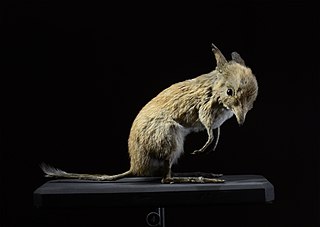
Macrotis is a genus of desert-dwelling marsupial omnivores known as bilbies or rabbit-bandicoots; they are members of the order Peramelemorphia. At the time of European colonisation of Australia, there were two species. The lesser bilby became extinct in the 1950s; the greater bilby survives but remains endangered. It is currently listed as a vulnerable species. The greater bilby is on average 55 cm (22 in) long, excluding the tail, which is usually around 29 cm (11 in) long. Its fur is usually grey or white; it has a long, pointy nose and very long ears, hence the reference of its nickname to rabbits.

The greater bilby, or simply bilby, is a long-eared, rabbit-like mammal native to Australia. It lives in burrows and is active at night, feeding on insects, fruit, or fungi. The bilby is a marsupial and carries its young in a pouch. Threats include habitat loss, disease, and introduced predators such as foxes. Formerly widespread, bilbies are now restricted to arid parts of northwestern and central Australia.

The order Peramelemorphia includes the bandicoots and bilbies. All members of the order are endemic to Australia-New Guinea and most have the characteristic bandicoot shape: a plump, arch-backed body with a long, delicately tapering snout, very large upright ears, relatively long, thin legs, and a thin tail. Their size varies from about 140 grams up to 4 kilograms, but most species are about one kilogram.

The desert bandicoot is an extinct bandicoot of the arid country in the centre of Australia.

The eastern barred bandicoot is a nocturnal, rabbit-sized marsupial endemic to southeastern Australia, being native to the island of Tasmania and mainland Victoria. It is one of three surviving bandicoot species in the genus Perameles. It is distinguishable from its partially-sympatric congener – the long-nosed bandicoot – via three or four dark horizontal bars found on its rump. In Tasmania, it is relatively abundant. The mainland population in Victoria is struggling and is subject to ongoing conservation endeavors.

Chaeropus, known as the pig-footed bandicoots, is a genus of small marsupials that became extinct during the 20th century. They were the only members of the family Chaeropodidae in order Peramelemorphia, with unusually thin legs, yet were able to move rapidly. Two recognised species inhabited dense vegetation on the arid and semiarid plains of Australia. The genus' distribution range was later reduced to an inland desert region, where it was last recorded in the 1950s; it is now presumed extinct.
The QIMR Berghofer Medical Research Institute is an Australian medical research institute located in Herston, Brisbane, in the state of Queensland. QIMR was established in 1945 by the Government of Queensland through the enactment of the Queensland Institute of Medical Research Act 1945 (Qld). Previously known as the Queensland Institute of Medical Research (QIMR), the original purpose of the institute was to further the study of tropical diseases in North Queensland. The current director is Professor Fabienne Mackay. The institute is a registered charity. In 2021, the institute was named as one of the Queensland Greats by the Queensland Government.

Perameles is a genus of marsupials of the order Peramelemorphia. They are referred to as long-nosed bandicoots or barred bandicoots.

The marsupial family Peramelidae contains the extant bandicoots. They are found throughout Australia and New Guinea, with at least some species living in every available habitat, from rainforest to desert. Four fossil peramelids are described. One known extinct species of bandicoot, the pig-footed bandicoot, was so different from the other species, it was recently moved into its own family.

The Western barred bandicoot, also known as the Shark Bay bandicoot or the Marl, is a small species of bandicoot; now extinct across most of its former range, the western barred bandicoot only survives on offshore islands and in fenced sanctuaries on the mainland.

The long-nosed bandicoot, a marsupial, is a species of bandicoot found in eastern Australia, from north Queensland along the east coast to Victoria. Around 40 centimetres (16 in) long, it is sandy- or grey-brown with a long snouty nose. Omnivorous, it forages for invertebrates, fungi and plants at night.
Bandicoot papillomatosis carcinomatosis virus is a circular double-stranded DNA virus isolated from bandicoots. The genome has features similar to viruses in the families Papillomaviridae and the Polyomaviridae. Two species have been described to date.

Klossiella is a genus of parasitic alveolates of the phylum Apicomplexa. Species in this genus infect the renal tract of mammals and intestinal tract of snakes.
Heirisson Prong is a community managed reserve established for the conservation of threatened mammals at Shark Bay in Western Australia. The reserve is at the point of a long narrow peninsula of the same name that juts into Shark Bay from the south.

Crash bandicoot is an extinct bandicoot, known from fossils located at the Riversleigh World Heritage Area in northeast Australia.
The Nullarbor barred bandicoot is an extinct species of bandicoot that was native to the arid Nullarbor Plain in southern Australia. It is also called the butterfly bandicoot for the dark brown patch on its rump, which resembles a butterfly. It was described in 2018 based on existing skins and osteological material within museum collections in Australia.
Kanyana Wildlife Rehabilitation Centre is a not-for-profit organisation and establishment located in Lesmurdie, Western Australia, dedicated to wildlife conservation by caring for sick, injured, orphaned and displaced native animals, breeding threatened native species, animal care training, research, and education through schools and local communities.
Perameles myosuros, the south-western barred bandicoot or marl, is a recently extinct species of bandicoot that was native to the southern parts of Western Australia. Initially described in 1841 it was later made a subspecies of the extant Perameles bougainville before being restored to species level in 2018, based on museum specimens. Of particular note was that the females were significantly larger than the males in P. myosuros, which is an unusual trait amongst mammals, whereas the sexes were the same size in P. bougainville.










